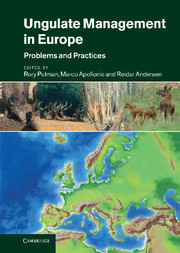Book contents
- Frontmatter
- Contents
- List of contributors
- Scientific names of species referred to in this text
- 1 Introduction
- 2 Status and distribution patterns of European ungulates: genetics, population history and conservation
- 3 A review of the various legal and administrative systems governing management of large herbivores in Europe
- 4 Hunting seasons in relation to biological breeding seasons and the implications for the control or regulation of ungulate populations
- 5 The census and management of populations of ungulates in Europe
- 6 Impacts of wild ungulates on vegetation: costs and benefits
- 7 Wild ungulate diseases and the risk for livestock and public health
- 8 Traffic collisions involving deer and other ungulates in Europe and available measures for mitigation
- 9 Large herbivores as ‘environmental engineers’
- 10 Ungulate–large carnivore relationships in Europe
- 11 The role of pathogens in the population dynamics of European ungulates
- 12 Climate change and implications for the future distribution and management of ungulates in Europe
- 13 Ungulate management in Europe: towards a sustainable future
- Index
- References
2 - Status and distribution patterns of European ungulates: genetics, population history and conservation
Published online by Cambridge University Press: 26 April 2011
- Frontmatter
- Contents
- List of contributors
- Scientific names of species referred to in this text
- 1 Introduction
- 2 Status and distribution patterns of European ungulates: genetics, population history and conservation
- 3 A review of the various legal and administrative systems governing management of large herbivores in Europe
- 4 Hunting seasons in relation to biological breeding seasons and the implications for the control or regulation of ungulate populations
- 5 The census and management of populations of ungulates in Europe
- 6 Impacts of wild ungulates on vegetation: costs and benefits
- 7 Wild ungulate diseases and the risk for livestock and public health
- 8 Traffic collisions involving deer and other ungulates in Europe and available measures for mitigation
- 9 Large herbivores as ‘environmental engineers’
- 10 Ungulate–large carnivore relationships in Europe
- 11 The role of pathogens in the population dynamics of European ungulates
- 12 Climate change and implications for the future distribution and management of ungulates in Europe
- 13 Ungulate management in Europe: towards a sustainable future
- Index
- References
Summary
Introduction
Within Europe as a whole, the distributional range, population size and the status of many species has been greatly influenced by human activity – not simply through the negative influences of humans on land-use patterns and in overexploitation, but also through active attempts to ‘restore’ and ‘augment’ species distributions.
A number of indigenous subspecies have been (or may be currently) threatened whether due to habitat loss, overexploitation or simply by lack of positive management to protect them. In addition, the genetic integrity of such endangered taxa may be compromised by the introduction to those populations of animals of different genetic background in misguided, although well-intentioned, attempts to bolster dwindling populations. Even within well-established populations apparently not under threat, introduction of animals of different genetic types may have been quite commonplace (usually in an attempt to try and improve the ‘trophy quality’ of antlers) – and thus the special genetic status of particular local populations has been greatly altered by the introgression of alien genes. Reintroduction of species to local areas from which they had previously become extinct has also often been undertaken without due regard to the genetic provenance of those individuals released, thus causing other discontinuities in genetic distributions.
- Type
- Chapter
- Information
- Ungulate Management in EuropeProblems and Practices, pp. 12 - 53Publisher: Cambridge University PressPrint publication year: 2011
References
- 44
- Cited by

